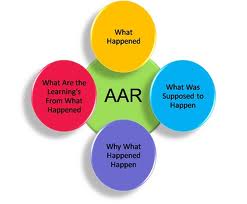After Action Review
The Army’s After Action Review (AAR) is arguably one of the most successful organizational learning methods yet devised. An AAR is a learning process that involves all the participants in a process from the lowest-ranking employees to board members, and can even included interested outsiders and observers.

An AAR focuses on the tasks and goals to discover why things happen, never to judge success or failure. An AAR is perhaps one of the ultimate performance improvement tools because it encourages all stakeholders to share and learn in order to have continuous improvement.
It may be thought of as a professional discussion of an event that enables employees to understand why things happened during the progression of the process and to learn from that experience. This technique can be used for any organizational project or programme.
The key to an AAR is openness and honesty, which allows all the participants in the organization to participate (Walden, 2009). This, in turn, allows the organization to capture what really happened so that lessons may be learned. It affords leaders and partners an opportunity to gain maximum benefit from every program, activity, or task.
Objectives of AAR
- Shared candid insights into specific strengths and weaknesses in the implementation of the Three Pillar Strategy from various perspectives
- Given Feedback and insight critical to improved performance
- Provided details that are often lacking in evaluation reports alone
AAR Process
AAR Ground Rules
The AAR is a professional discussion that includes the participants and focuses directly on the tasks and goals. It is not a critique. In fact, it has several advantages over a critique:
- It does not judge success or failure.
- It attempts to discover why things happened.
- It focuses directly on the tasks and goals that were to be accomplished.
- It encourages employees to surface important lessons in the discussion.
- More employees participate so that more of the project or activity can be recalled and more lessons can be learned and shared.
AAR Activity Advice
- Review events leading to the activity (what was supposed to happen).
- Give a brief statement of the specific activity.
- Summarize the key events. Encourage participation.
- Have junior leaders restate portions of their part of the activity.
The following will help:
- Ask why certain actions were taken.
- Ask how they reacted to certain situations.
- Ask when actions were initiated.
- Ask leading and thought provoking questions.
- Exchange war stories (lessons learned).
- Ask employees what happened in their own point of view.
- Relate events to subsequent results.
- Explore alternative courses of actions that might have been more effective.
- Complaints are handled positively.
- When the discussion turns to errors made, emphasize the positive and point out the difficulties of making tough decisions.
- Summarize.
- Allow junior leaders to discuss the events with their people in private.
Follow-up on needed actions.
Information for Facilitators
- Remain unbiased throughout the review.
- Try to speak to draw out comments from all.
- Do NOT allow personal attacks.
- The focus should be on learning and continuous improvement.
- Strive to allow others to offer solutions, rather than you offering them.
A properly conducted AAR can have a powerful influence on the climate of your organization. It is part of the communication process that educates and motivates people on to greatness by sensitizing them to do the right thing. It can prevent future confusion on organizational priorities and philosophies and drive home the point that we learn from our mistakes.
Conclusion
Organizational agility is an emergent quality arising from building blocks such as discipline around shared understanding of intent and regular candid conversations about results. Such cultural norms undergird the likelihood that aligned, agile action will emerge during period of crisis or unexpected results.


